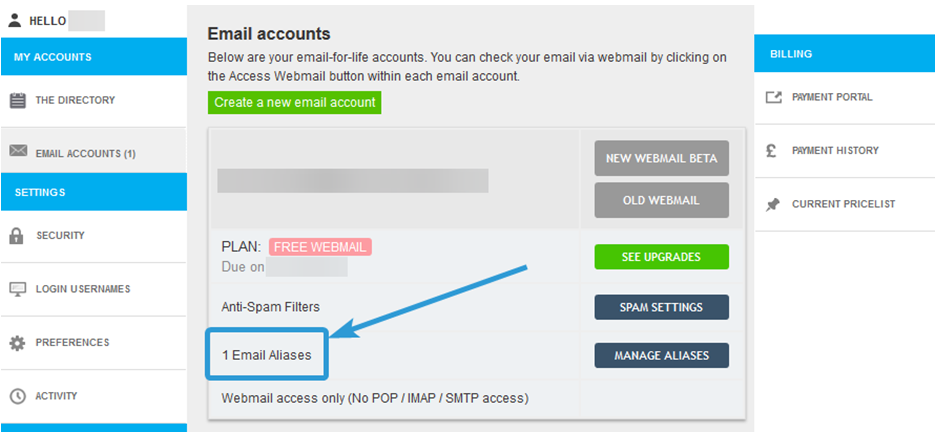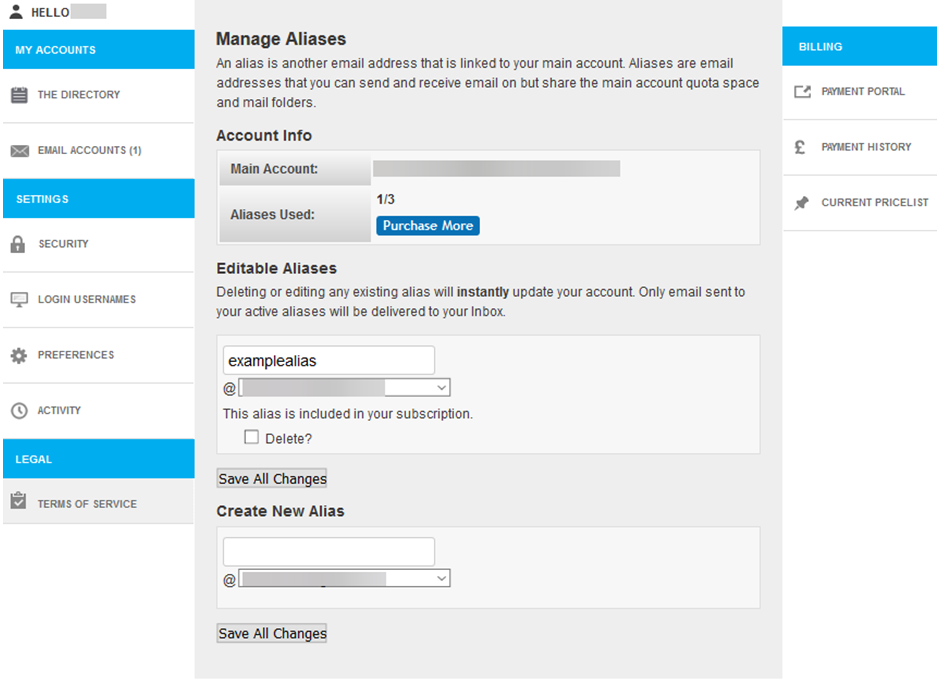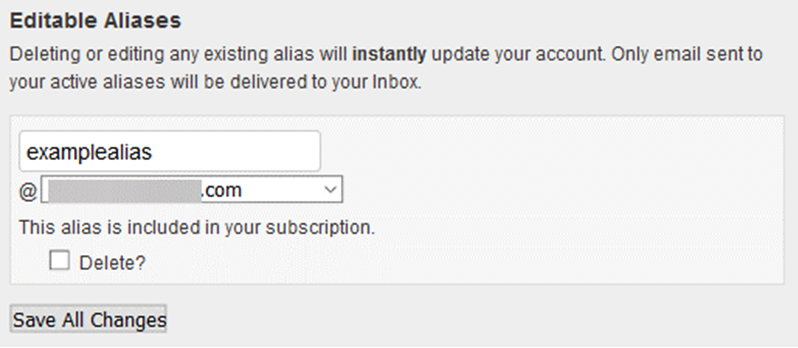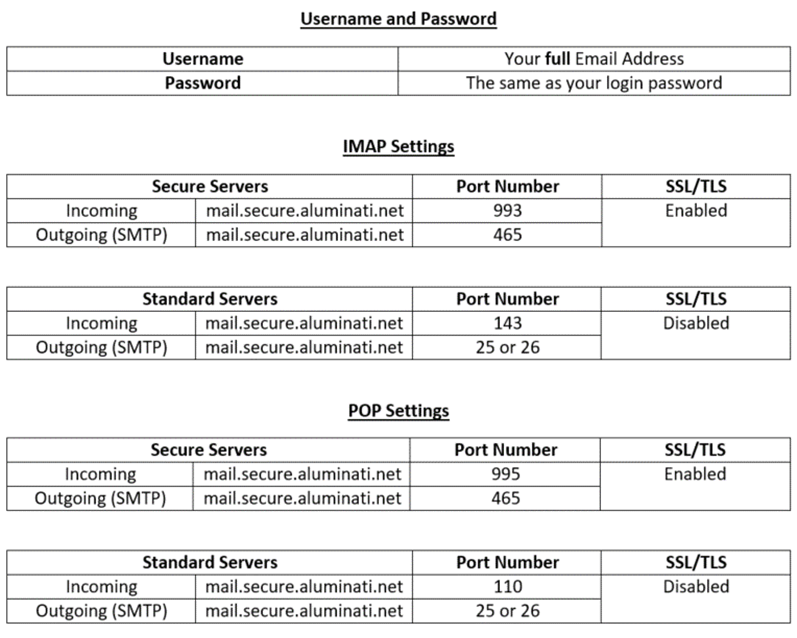Frequently Asked Questions
- About our accounts
- Email Account How-Tos
- How do I renew a FREE subscription?
- How do I change my email address or username?
- How do I upgrade my account?
- How do I use multiple identities?
- How do I set up email filters?
- Getting started
- Glossary
- Most Common Questions
- What is the total maximum file size an email attachment can be?
- Aliases
- How do I set up/manage my aliases?
- How can I archive my emails for safekeeping or transfer?
- I can't send/receive emails from my mail client/phone.
- Registration
- Tips and information
- Troubleshooting
What is an Alias?
Your Email account will come with a number of Aliases that you may wish to use as another email address for your account. When an email is sent to an Alias, it will be delivered to your main email addresses inbox.
This is useful if you wish to set up another email address for different contacts, or if your name has changed recently.
Aliases are like giving your house a name. For example, let's say your address is 9 Colne Road, but you have put up a sign calling it The Orchard. Your address is still 9 Colne Road, and your post will still be delivered there. But it is also known as The Orchard, so post addressed to The Orchard will also be delivered.
How many Aliases can my account have?
You can view how many Email Aliases your Account can have by going to the My Account dashboard after logging in. Once here, click on Email Accounts on the left hand side. You will see the Aliases displayed in the Account information:

Your account will include at least one free Alias. If you have upgraded your Account, you will have access to more Aliases. To view how many Aliases each of our Packages includes, you can visit our help guide here.
To edit or set up your Aliases, you can click on the Manage Aliases button. You can find a help guide that details this more here.
If you have any questions about Aliases, please contact our helpdesk at help@aluminati.net
Aliases allow you to set up an additional email address on your account. To read more about Aliases, please see our help guide here.
You can set up and manage your Aliases by logging in to your Account and going to the My Account dashboard. If you are logged in to your webmail inbox, you can access My Account by clicking on the button in the top right of the page.
On the My Account page, you will be able to click on Email Accounts on the left. This will show you all the email accounts you currently own. Each of your email accounts will have a Manage Aliases button. It will also list how many Aliases you can have on your email account.
Clicking on Manage Aliases will take you to the page in order to set up or edit your Aliases.
If you are already using all of your Aliases and would like more, you can click on Purchase. This will take you to the Payment Portal, and you can select a Package or Bolt-On if you would like more Aliases.

- To add an Alias: Use the Create New Alias box to set up a new Alias. You can choose what address the Alias has, and can select which domain you wish to use from the dropdown. You can then click Save All Changes to save your new Alias.

- To edit an Alias: If you have an Alias already set up, it will appear in the Editable Aliases section. If you wish to change the Alias address, simply change it in the text box. You can also choose a different domain if these are available, by selecting this from the dropdown box. You can then click Save All Changesto save the changes you have made.
You can update an Alias as much as you want, but when you update it, it will delete the old one. If an email is then sent to the old Alias, it will be bounced back to the sender. The new Alias you have set up will be active immediately, and emails can be sent to it as soon as you have saved it.

- To delete an Alias: If you wish to remove an Alias completely, you can select the Delete? Tickbox in the Editable Aliases section. Once you have ticked this box, you can click Save All Changes to remove the Alias from your email account.
If an email is then sent to the deleted Alias, it will be bounced back to the sender.
If you would like to set up your email account to send emails from your alias, you can set it up as a Multiple Identity. You can read more about Multiple Identities in our help guide here.
If you have any questions about setting up or editing your Aliases, please contact our helpdesk at help@aluminati.net
- Log into Webmail and select the email you would like to archive
- Then click on More and select Download (.eml)
- The email will then be downloaded to a file on your device
If you want to archive more than 100 messages at a time (This option is only available for paid accounts)
(This method is best if you want to archive more than 100 messages at a time, and is generally recommend as a much more convenient way of downloading emails to your computer.)
Set up a mail client (such as Outlook, Thunderbird, or Mac Mail) to connect with your account via IMAP. If you are not sure how to do this, this article will help you.
Once you have your email account set up, just drag and drop the chosen messages to a local folders file on your computer. At this point you will want to make sure your computer is backed up, as those files will no longer be on our servers.
Some account packages come with access to IMAP/POP/SMTP, which allows them to be added to an Email Program or App. If you are unable to send or receive emails from your Account on an email program or app, please follow the troubleshooting steps below.
Check your account package
If you are repeatedly informed that your username/password is invalid despite it being entered correctly, it could be that you have an account without IMAP/POP/SMTP access.
You can find out if your account has this enabled by logging in to the My Account dashboard. If you click on Email Accounts on the left, you will see details of your email account and what Package it is currently using. It will also list if your account has access to IMAP/POP/SMTP.
If you do not have access to IMAP/POP/SMTP, it will be shown as Webmail access only:

If you wish to upgrade your account to include this feature, you can do so by clicking on the See Upgrades button on the same page.
Check the settings of your email program or app
If your Account is set up with IMAP/POP/SMTP access, you will have to check the settings for your Account in your Email Program or App. If you are unable to find where these settings are, please refer to the help guides that came with the Email program or app you are using.
The settings will need to be set up as follows, depending if you are using IMAP or POP, and if you wish to use Secure or Standard connections:

Check username and password fields even where 'optional'
In your client's account settings, you need to make sure the username and password are filled in even if it says the information is optional. You will need to enter your full email address in to the username field.
Change port number
If you can receive emails but are unable to send them, check your outgoing server settings. If the port is 25, try changing it to 26. Some ISPs block port 25 to try and cut down on the amount of spam sent from their networks. Changing it to 26 usually circumvents this, though in some instances port 26 will also be blocked, and port 587 should be tried instead.
Please refer to the settings above for details of the different configurations that can be used to set up your email address.
Contact us
If none of the solutions here have worked for you, please contact our helpdesk at help@aluminati.net with your email address, the full error message you are receiving, and as much information as possible about what issue you are experiencing.
Files attached to an email on the ed-alumni.net service must not total more than 25MB.
The main reason for this file size limit is security. Without these limits it would be possible for malicious users to bombard email servers with huge email attachments and ultimately crash the servers. Even if we were to increase the file size limit on our end, there is no way of ensuring that a recipient's server would accept a file of that size.
If the file attachment size is too big, and rejected by the recipient's server, you will usually be notified with what is known as a bounce message. These exist primarily to inform users that their email has not been received, and provides a brief reason why.
Should you wish to send a file to a recipient that is over 25MB in size (or has otherwise been rejected by their mail server) there are two alternatives available that would allow you to work around these limits:
- Using a cloud storage or FTP link (a solution such as Dropbox, Google Drive, etc.) can provide users with a link to download the file, this can then be inserted into an email.
- Using file compression software (such as Winzip, or the native functionality built into most operating systems) to make the file smaller for the purposes of attachment.